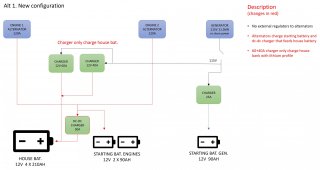nilsson_lina
New Member
- Joined
- Aug 6, 2022
- Messages
- 6
Hi all,
I recently found this forum and it seems great. I've been searching and not found answers to all my questions. So I thought perhaps I could reach out and ask for some advice.
My house batteries on my boat are going bad. I need to replace them the coming months. So I thought I should install Lithium instead. But I understand there are a few things I need to consider and do to make it a safe but still easy installation. That is where I hope to get some advice from this forum.
A few details about my ideas and needs:
If I change the house battery bank to Lithium. What do I need to do with this configuration to make it a safe and reliable system?
Especially thinking about the setup with the alternators and the combination with my old starting batteries and new lithium batteries.
What would be your best configuration and advice?
Thanks in advance

I recently found this forum and it seems great. I've been searching and not found answers to all my questions. So I thought perhaps I could reach out and ask for some advice.
My house batteries on my boat are going bad. I need to replace them the coming months. So I thought I should install Lithium instead. But I understand there are a few things I need to consider and do to make it a safe but still easy installation. That is where I hope to get some advice from this forum.
A few details about my ideas and needs:
- I want to keep my starting batteries and only change the house bank to lithium
- I don't plan to have a lot of solar, only a few panels at the moment. (not included in the schematic below)
- I want to add approx 4 x 200Ah Lithium batteries that are reliable and safe (i don't want to build them myself.
- The charger I have has a lithium profile
- The alternators I have are "stupid" not regulated
If I change the house battery bank to Lithium. What do I need to do with this configuration to make it a safe and reliable system?
Especially thinking about the setup with the alternators and the combination with my old starting batteries and new lithium batteries.
What would be your best configuration and advice?
Thanks in advance

Last edited:




